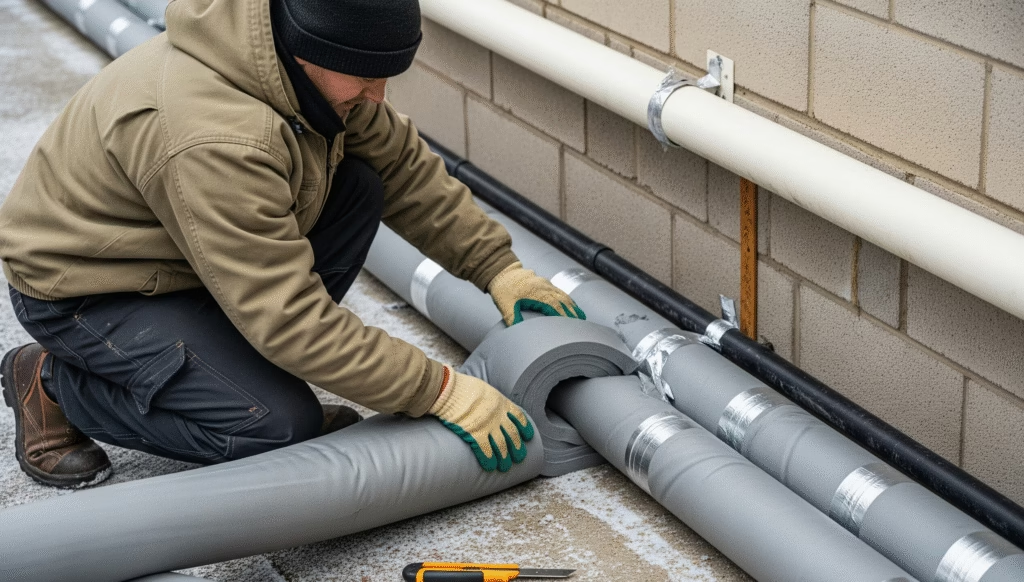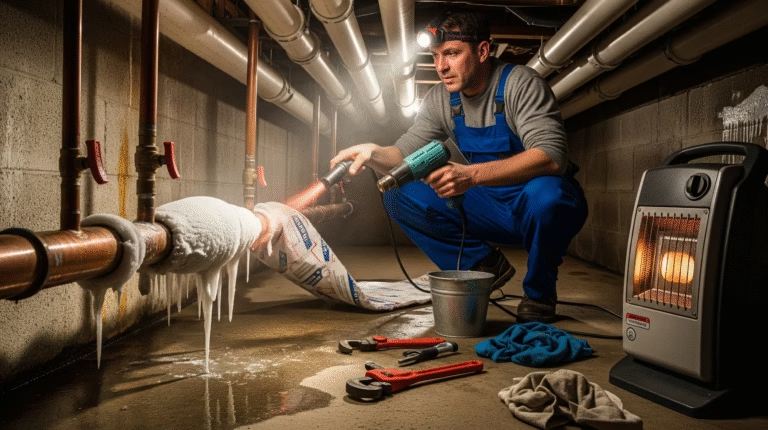The biggest challenge that comes with winter is how to fix frozen pipes. As the temperature drops, our pipes get clogged, and thawing frozen pipes becomes a necessity in our daily lives. So, it becomes necessary to take certain measures so that Pipes can be protected from future damage. In this guide, we will try to understand how frozen pipes can be fixed and how to reduce plumbing costs in a step-by-step guide.
At What Temperature do pipes freeze in winter
Whenever the temperature drops, the water inside plastic or any type of pipe freezes, which causes blockages in them. The water freezes and blocks the flow out of the tap. But the biggest and most dangerous thing is that when water freezes, it expands, which increases the risk of bursting pipes and causing flooding, so it is important for every homeowner to know at what temperature pipes freeze and how to repair frozen pipes. If our pipes are constantly at 20 degrees Fahrenheit or lower, the risk of our pipes freezing increases.
Main Factors that Cause Frozen Pipes
Many factors cause pipes to freeze in winter, some of which are:
1. Temperature
When the temperature hits minus six degrees Celsius and 20 degrees Fahrenheit, pipes start to freeze.
2. Sudden cold weather
In areas where winters are not very severe, pipes can freeze due to lack of proper insulation.
3. Lack of proper insulation
If the pipes are bare or not insulated
4. Location of pipes
Pipes that are in basements, attics, crawl spaces, or in external walls are more likely to become clogged due to temperature and location.
How to Prevent Frozen Pipes Before They Happen
- If there is a crack in your pipe, seal it immediately.
- Insulate the pipe anywhere so that it does not freeze.
- Keep all cabinet rolls under the sink open.
- Always keep the taps running.
- Ensure regular drip by keeping the tap a little bit open.
- Disconnect external pipes and taps
- Keep your home temperature at least 55 degrees Fahrenheit. Have a relative or friend check your home while you’re traveling.
Potential Warning Signs of Frozen Pipes
- The home’s central heating system gives off warning signs when it is on.
- The water in the home’s taps stops flowing.
- Your sink clogs, and the toilet’s flushing slows down.
- Your boiler stops turning on.
- The home’s central heating system starts making gurgling sounds.
- You see little icing on the pipes.
- You can feel a strange smell through the sink or baths.
Essential Tools to Fix Frozen Pipes
- Safety gloves
- Light for illumination
- An adjustable range
- Bowls, towels, and a cloth for absorbing
- A thermometer to check the temperature of the pipes
- Hair dryer or heat gun on low setting
- Warm or electric heating pad

Frozen pipes not only stop the water flow but also increase the risk of the pipes expanding and bursting, which can lead to leaks and flooding. In such a case, you need a quick fix to avoid further damage. Here is a quick step-by-step guide to fix it.
Identifying Frozen Pipes
If the water supply is shut off, you need to trace the pipes. For this, monitor the water pressure or trace back from the tap to a place where the water is completely shut off and locate the frozen section.
Turn off the main water supply to your home. This will protect you from gushing water after the pipe opens.
Turn on the faucet.
Even a single drop of water will reduce the pressure in the pipe and remove the ice blockage.
Apply heat to the frozen area.
Using Gentle Heat: Frozen pipes can be thawed slowly by applying gentle heat. Avoid using open flames, as this increases the risk of fire in non-metal pipes. Here are some safety tips for applying heat.
There are different ways to apply heat to the pipe.
Use a hair dryer.
- Slowly heat the pipe on a low heat setting, starting at the end of the pipe and gradually working your way up to the coldest section.
- If you move the hair dryer up and down, the pipe will slowly become thinner due to the distributed heat it provides.
Using a space heater
- Position the space heater in front of the affected pipe and apply gentle heat instead of direct heat. Be sure to be safe during this process and monitor the entire process carefully.
- Using thermostatically controlled heat tape, carefully wrap it around the frozen pipe. This will start the thawing process by applying heat to the inside of the pipe and will prevent the pipe from freezing even in the long run.
- Using a hot towel, wrap the hot towel around the rosin-located pipe, and when it cools, replace it and reheat it.
Using a Propane Gas Torch
- Using a propane gas torch is the fastest and trickiest way to thaw the pipes, but it requires the help of a professional who gently applies the flame
- If your frozen pipe is accessible and it is safe for you, pour hot water over it, starting near the tap and moving toward the blockage. Remember, safety is paramount.
The challenge of exposing hidden pipes
- Discovering pipes that are concealed in walls or ceilings is a big challenge. This challenge can be overcome through these methods.
- Increase the temperature of the house, which will start thawing the pipes indirectly.
- Increase the use of space heaters near the vents.
- In some cases, you may have to expose the pipes.
- You need to drill a hole in the drywall and ceiling, then warm it up by any of the above-mentioned safe heating methods.
4 Precautions to Fix Frozen Pipes
- Most importantly, never insert any object into drinking water pipes, as doing so can cause health concerns.
- The most important thing to do to fix frozen pipes is to carefully inspect them to find the exact location.
- Always isolate the damaged pipe from the rest of the pipeline and disconnect its water supply.
- Before restoring the water supply, make sure that there are no cracks in the pipes that were frozen.
How to Prevent Pipes from Freezing Again in the Future
You can take the following tips to prevent a burst water pipe
- Always seal pipe entry points
- Always set the thermostat to 55 degrees Fahrenheit.
- Always insulate pipes.
- Shut off and drain all faucets before winter sets in.
- Keep all faucets in the house, especially those outside, in the dripping position.
- Install small leak detectors in your home that connect to smartphones.
- Use pipe heating cables.
- Use cables
- Schedule an annual plumbing inspection.
Important Tip
Whenever you change the pipes, change the temperature gradually instead of suddenly so that there is no risk of the pipe bursting. If the pipe ever bursts, immediately turn off the main water supply and call the number or repair service.
Conclusion
Frozen pipes are the biggest problem in winter. They not only damage our property if they are not properly checked, but they can also cause us financial losses. But if you follow these winter plumbing tips and take precautions, the water in your home can be smooth. If you have friends who live in cold climates and go through this problem, share this guide with them and let them beat the winter before the winter beats them too.
FAQs
Do plastic pipes freeze, too? Yes, PVC, copper, and PEX are all free pipes. Do all pipes that freeze burst?
No, this can happen if the pressure is high.
Should I turn off the heating system even if I am not at home?
Yes, it can be done, keeping safety in mind.
Does insurance cover this damage?
This happens often. You should still take precautions
How long does it take for pipes to become clogged?
This can be from 30 minutes to several hours.
Overall Rating
What Customers Say
There are no reviews yet. Be the first one to write one.

Leave a Reply